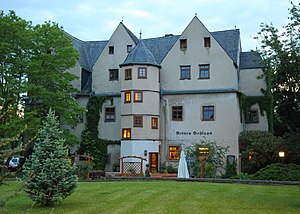Gray lock
| Gray lock | ||
|---|---|---|
|
View from the south (2016) |
||
| Creation time : | around 1200 | |
| Castle type : | Niederungsburg | |
| Conservation status: | Remains of the wall from the main building have been preserved | |
| Standing position : | Noble | |
| Place: | Mihla | |
| Geographical location | 51 ° 4 '40.9 " N , 10 ° 19' 54.4" E | |
| Height: | 190 m above sea level NN | |
|
|
||
The Gray Castle is a former residential castle that was built on the foundation walls of a medieval moated castle on the banks of the Werra near Mihla in the Wartburg district in Thuringia . Its structural remains are located at a height of 190 meters in the west of the historical location of Mihla, directly on the banks of the Werra and the Lauterbach river that flows into it.
history
In the immediate vicinity of the Mihlaer Martinskirche was a medieval moated castle. It was inhabited by the Lords of Mihla, feudal men of the Archbishops of Mainz and the Thuringian Landgraves, a branch of the Schlotheim Truchsess . In 1399 the lords of Roßdorf were enfeoffed with Mihla, followed by Heilingen and Wangenheim . In 1436 the von Harstall aristocratic family acquired the site and castle seat of Mihla, and they became feudal lords and court lords.
Conversion to a castle
At the beginning of the 16th century, von Harstall began converting this castle into a residential palace. Here, immediately to the east, an extensive manor - the so-called White Castle - was built or expanded, of which ancillary buildings still exist today; It was canceled in 1836. The third palace complex was the Red Palace, also owned by the Harstalls, on the other side of the Lauterbach on the way to Eisenach and Creuzburg .
Storming of the castle in 1848
During the unrest in March 1848 the farm and farm workers rose up in Mihla to fight for the improvement of their living conditions. The Gray Castle was stormed on March 13, 1848, and the then landowner and court lord, but also various village leaders and even the Mihla pastor had to sign prepared waivers of taxes and interest charges. On March 17th, military summoned from Eisenach stormed the occupied castles and the parish and captured the leaders of the riot. As a result, the most important result was the separation of the plots, at least part of the feudal burdens were abolished. A later amnesty by the state government led to the release of those arrested.
Current situation and usage
The von Harstall family was expropriated without compensation in 1945 with the Gray Castle and manor of 523 hectares. In 1971 the Gray Castle was set up as a restaurant. The palace complex is a designated architectural and ground monument in Mihla and is privately owned. The castle complex is still used as an inn and hotel. For this purpose, the interiors were gradually renovated in the 1990s. Around the building there is an area used as a park with old trees and several memorial stones.
The 250 to 300 year old linden tree in front of the Gray Castle had been designated as a natural monument since 1966 . It had to be felled in autumn 2013 because the stability was no longer guaranteed.
description
The complex, built from rubble stones , corresponds to the typical Renaissance style of the residential castles in the lower and middle Werra Valley and resembles the castle buildings in Nesselröden and Madelungen . The building is made of local limestone and has three high gable bay windows on the north and south sides. The rectangular floor plan shows a protruding stair tower on the south side and a lower porch on the east side. The surrounding moat was already filled in in the 19th century. Inside, representative rooms have been preserved, especially on the ground floor and first floor.
literature
- Thomas Bienert: Mihla. Red lock and gray lock . In: Medieval castles in Thuringia . Wartberg-Verlag, Gudensberg-Gleichen 2000, ISBN 3-86134-631-1 , pp. 329-330.
- Rainer Lämmerhirt: History of Mihlas. The development of the place from the beginning to the end of the First World War . Heimat- und Verkehrsverein, Mihla 1992, ISBN 3-87022-180-1 .
Web links
Individual evidence
- ^ Biedermann: Natural monuments in the Wartburg district; District Office Wartburgkreis, 2014, page 33



